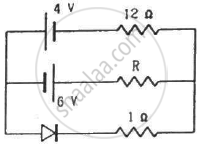Advertisements
Advertisements
प्रश्न
When a p-n junction is reverse-biased, the current becomes almost constant at 25 µA. When it is forward-biased at 200 mV, a current of 75 µA is obtained. Find the magnitude of diffusion current when the diode is
(a) unbiased,
(b) reverse-biased at 200 mV and
(c) forward-biased at 200 mV.
उत्तर
Given:
Drift current (current under reverse bias), i1 = 25 µA
Forward bias voltage, V = 200 mV
Net current under forward bias, i2 = 75 µA
(a) When the p‒n junction is in unbiased condition, no net current flows across the junction.
i.e. Drift current = Diffusion current
∴ Diffusion current = 25 µA
(b) Under reverse bias, the built in the potential and applied voltage opposes the motion of the majority carriers across the junction.
Thus, the diffusion current becomes zero.
(c) Under forward bias, the voltage supports the motion of majority carriers across the junction.
Let the actual current be x.
So,
(x − Drift current) = Forward-biassed current
\[\Rightarrow x - 25 \mu \text{ A }= 75 \mu \text{A}\]
\[ \Rightarrow x = (75 + 25) \mu \text{ A }\]
\[ \Rightarrow x = 100 \mu \text{ A }\]
APPEARS IN
संबंधित प्रश्न
In an unbiased p-n junction, holes diffuse from the p-region to n-region because ______.
Write the two processes that take place in the formation of a p-n junction.
A zener diode is fabricated by heavily doping both p- and n- sides of the junction. Explain, why?
Explain briefly with the help of necessary diagrams, the forward biasing of a p-n junction diode. Also draw characteristic curves.
Explain briefly with the help of necessary diagrams, the reverse biasing of a p-n junction diode. Also draw characteristic curves.
A student wants to use two p-n junction diodes to convert alternating current into direct current. Draw the labelled circuit diagram she would use and explain how it works.
Explain, with the help of a circuit diagram, the working of a photo-diode. Write briefly how it is used to detect the optical signals.
Explain, with the help of a circuit diagram, the working of n-p-n transistor as a common emitter amplifier.
The diffusion current in a p-n junction is
Two identical p-n junction may be connected in series with a battery in three ways. The potential difference across the two p-n junctions are equal in

In a p-n junction,
(a) new holes and conduction electrons are produced continuously throughout the material
(b) new holes and conduction electrons are produced continuously throughout the material except in the depletion region
(c) holes and conduction electrons recombine continuously throughout the material
(d) holes and conduction electrons recombine continuously throughout the material except in the depletion region.
In a p-n junction, a potential barrier of 250 meV exists across the junction. A hole with a kinetic energy of 300 meV approaches the junction. Find the kinetic energy of the hole when it crosses the junction if the hole approached the junction (a) from the p-side and (b) from the n-side.
Find the current through the battery in each of the circuits shown in figure.

(Assume that the resistance of each diode is zero in forward bias and is infinity in reverse bias.)
Find the current through the resistance R in figure if (a) R = 12Ω (b) R = 48Ω.

(Assume that the resistance of each diode is zero in forward bias and is infinity in reverse bias.)
Draw the current-voltage characteristics for the device show in figure between the terminals A and B.

(Assume that the resistance of each diode is zero in forward bias and is infinity in reverse bias.)
An AC source is connected to a diode and a resistor in series. Is the current thorough the resistor AC or DC?
p-n junction diode is formed
Zener breakdown occurs in a p-n junction having p and n both:
During the formation of a p-n junction ______.
